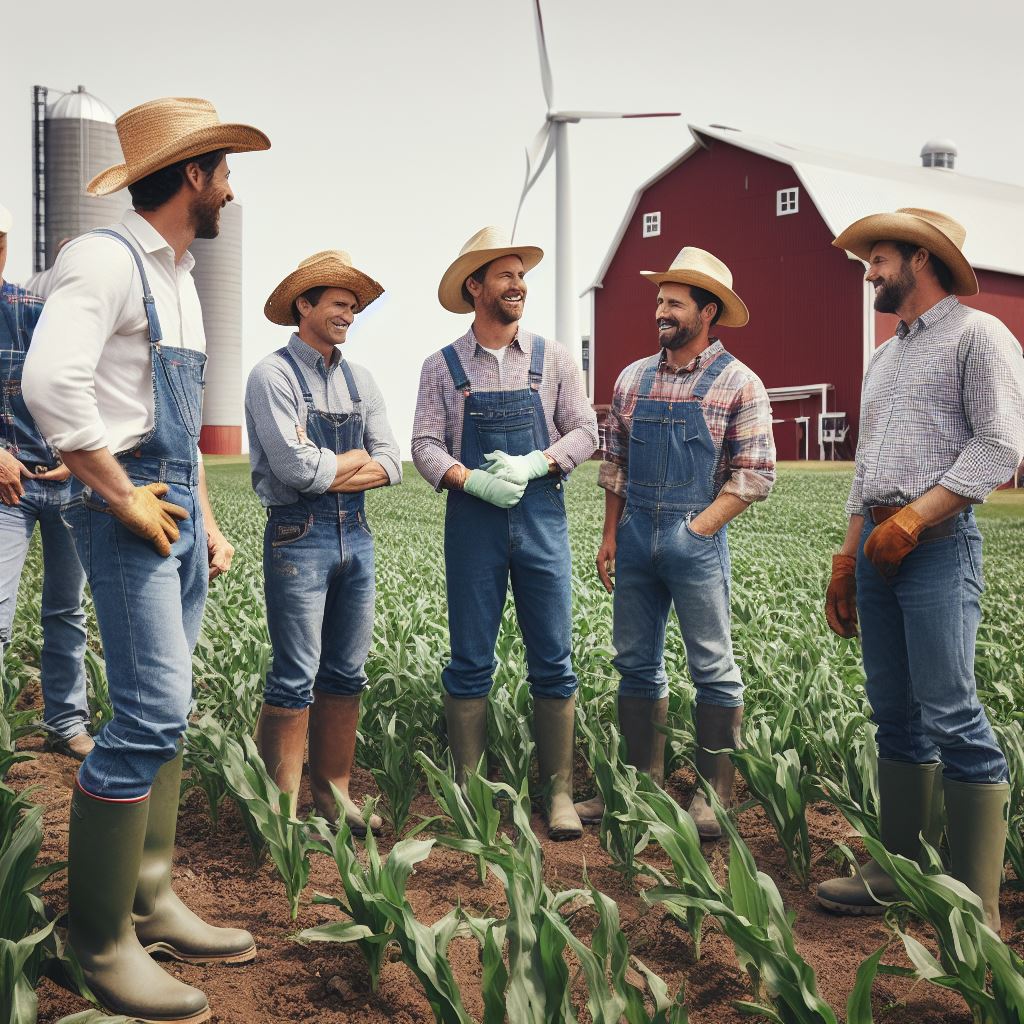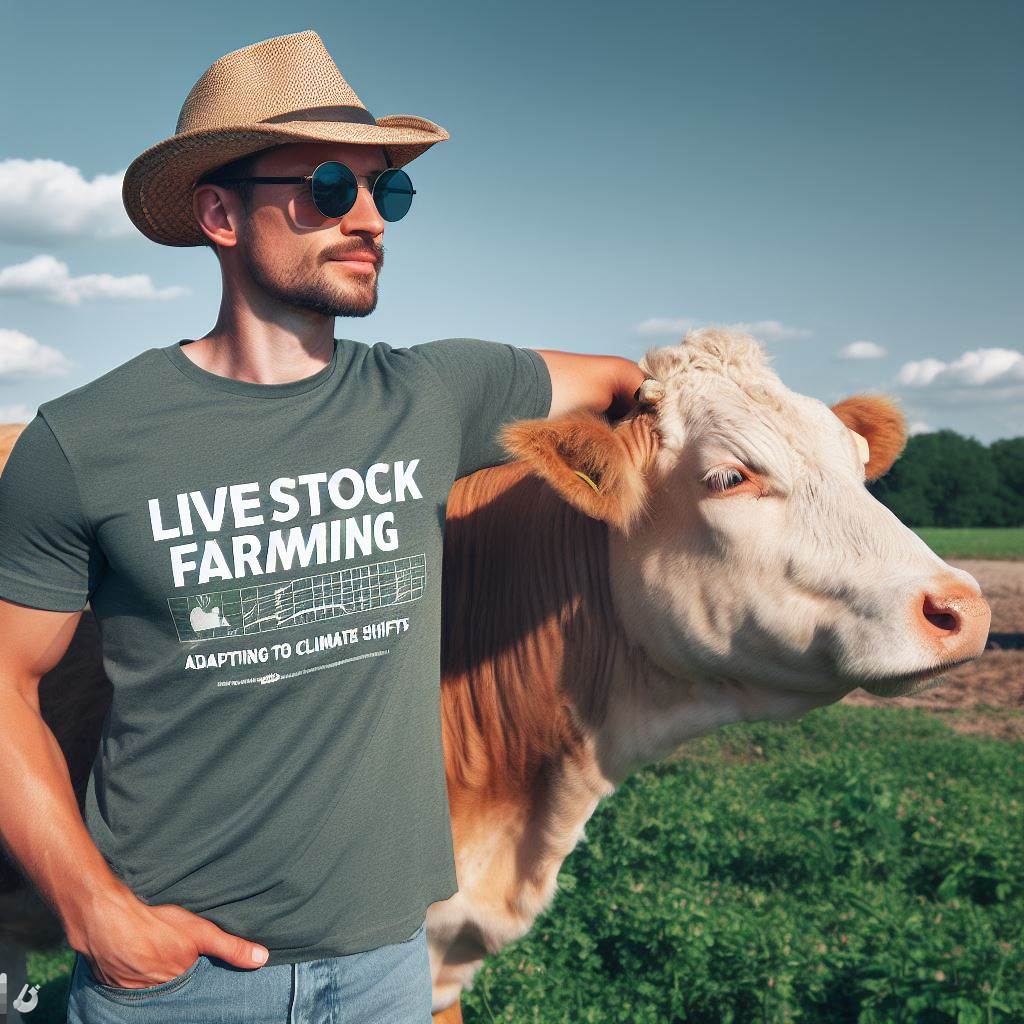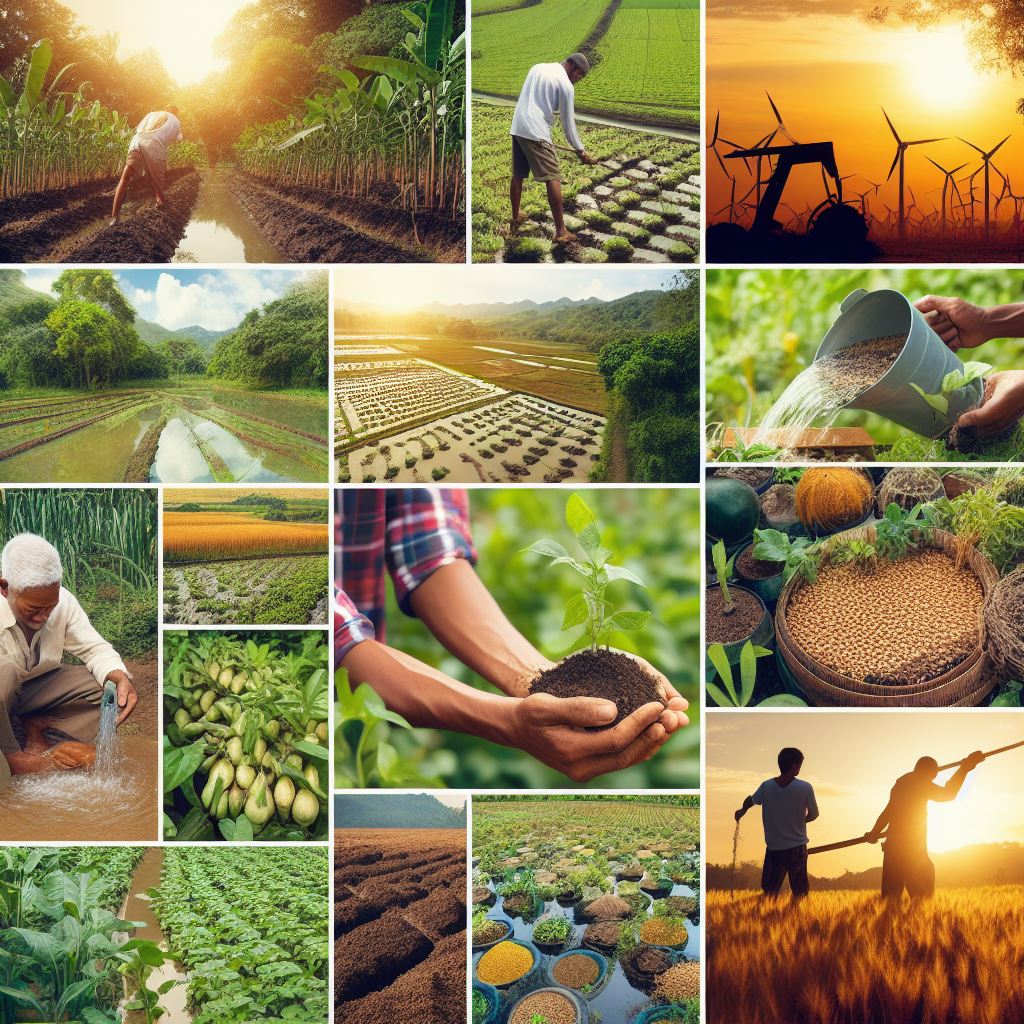Introduction
Carbon farming is an agricultural practice that sequesters carbon dioxide from the atmosphere into the soil.
Addressing climate change in agriculture is crucial as it helps mitigate greenhouse gas emissions and promotes sustainability.
In the realm of sustainable agriculture, a revolutionary practice has emerged, promising to be a game-changer in the fight against climate change: Carbon Farming.
Transforming fields into potent carbon sinks, this innovative approach not only nurtures crops but also mitigates the adverse effects of greenhouse gases.
In the following chapters, we delve into the intricate web of carbon farming, exploring its diverse techniques and far-reaching implications.
From cover crops to rotational grazing, each method plays a pivotal role in sequestering carbon, ultimately contributing to a resilient and regenerative agricultural landscape.
As we unravel the layers of this eco-friendly strategy, we’ll uncover the untapped potential within our fields and its significant impact on the future of sustainable farming.
Join us on this journey through the fertile grounds of Carbon Farming, where agriculture meets climate promise.
The link between agriculture and climate change
As the world grapples with the effects of climate change, one industry that plays a significant role in contributing to greenhouse gas emissions is agriculture.
The link between agriculture and climate change is undeniable, and it is vital that we address this connection to create a sustainable future for our planet.
1. The role of agriculture in contributing to greenhouse gas emissions
- Livestock production: The rearing of animals for meat and dairy products is a leading contributor to greenhouse gas emissions.
The methane released from livestock, particularly cattle, is a potent greenhouse gas that significantly contributes to global warming. - Deforestation for agriculture: Clearing forests for agricultural purposes, such as expanding croplands or creating pasture for livestock, releases massive amounts of carbon dioxide into the atmosphere.
This deforestation not only eliminates carbon sinks but also reduces biodiversity. - Fertilizer use: While fertilizers play a crucial role in increasing agricultural productivity, their use releases nitrous oxide, which is a potent greenhouse gas.
Nitrous oxide is released from both synthetic and organic fertilizers, contributing to climate change. - Rice cultivation: Rice is a staple crop for many countries, particularly in Asia.
However, the flooded paddy fields emit large quantities of methane, as anaerobic conditions occur during rice growth.
This methane contributes to global warming and climate change.
2. Negative impacts of climate change on agricultural productivity
- Changing weather patterns: Climate change has resulted in more frequent and severe weather events, such as droughts, floods, and heatwaves.
These extreme weather conditions affect crop growth and livestock production, leading to reduced agricultural productivity. - Pests and diseases: Rising temperatures and shifting climate patterns create favorable conditions for pests and diseases to thrive.
This puts crops and livestock at a higher risk, resulting in reduced yields and increased economic losses for farmers. - Water scarcity: Climate change exacerbates water scarcity in many regions.
A lack of water affects crop irrigation, productivity, and quality.
Decreased water availability also impacts livestock, leading to poor health and lower productivity. - Loss of biodiversity: Climate change negatively impacts ecosystems, leading to the loss of biodiversity.
This loss affects pollinators like bees, which are essential for crop production.
Without adequate pollination, agricultural productivity decreases significantly. - Food security: The combination of reduced agricultural productivity, changing weather patterns, and increased pest pressure poses a threat to food security.
Climate change puts global food supplies at risk, particularly in vulnerable regions already facing challenges in food production.
Addressing the link between agriculture and climate change is crucial for the sustainability of both our environment and food systems.
However, it is not all doom and gloom.
Carbon farming, an agricultural approach that emphasizes carbon sequestration and reducing greenhouse gas emissions, offers promise.
By implementing practices such as cover cropping, rotational grazing, agroforestry, and organic farming, farmers can help mitigate climate change.
These practices enhance soil health, sequester carbon, and reduce the need for synthetic fertilizers and pesticides.
Additionally, promoting agroecological farming systems and supporting small-scale farmers can contribute to both climate action and sustainable development.
Transform Your Agribusiness
Unlock your farm's potential with expert advice tailored to your needs. Get actionable steps that drive real results.
Get StartedIn short, agriculture plays a significant role in contributing to greenhouse gas emissions, primarily through livestock production, deforestation, fertilizer use, and rice cultivation.
Furthermore, climate change has negative impacts on agricultural productivity, affecting crop growth, livestock health, and water availability.
Addressing this link between agriculture and climate change is crucial to ensure food security and create a sustainable future.
By adopting carbon farming practices and supporting agroecological farming systems, we can take steps towards mitigating climate change while promoting sustainable agriculture.
Read: Coastal Farms: Rising Sea Levels’ Big Impact
What is Carbon Farming?
Carbon farming is a set of practices aimed at reducing greenhouse gas emissions from agricultural activities.
It strives to capture and store carbon in agricultural soils to mitigate climate change.
Defining Carbon Farming and its Goals
- Carbon farming involves implementing farming techniques that enhance carbon sequestration in soils.
- Its primary goal is to combat climate change by reducing atmospheric carbon dioxide levels.
- The practices focus on increasing soil organic matter, improving soil health, and optimizing nutrient cycles.
- Carbon farming also aims to boost agricultural productivity and resilience to climate-related challenges.
Practices Involved in Carbon Farming
There are several practices integral to carbon farming, each with its specific benefits and contributions:
Cover Cropping
- Cover cropping involves planting non-commercial crops to cover the soil during fallow periods.
- These cover crops prevent soil erosion, enhance water retention, and promote microbial activity.
- They also capture atmospheric carbon and convert it into organic matter through photosynthesis.
- By incorporating cover crops into the soil, carbon storage is increased, improving soil fertility and structure.
- The practice also helps suppress weeds and reduces the need for synthetic fertilizers and pesticides.
Rotational Grazing
- Rotational grazing involves controlled movement of livestock across various pasture areas.
- This practice allows for periods of rest and regrowth for pastures, promoting healthy plant growth.
- It prevents overgrazing and reduces soil compaction, enhancing its capacity to sequester carbon.
- Livestock waste also enriches the soil, contributing to increased organic matter content.
- Rotational grazing systems improve biodiversity, reduce erosion, and enhance nutrient cycling.
Agroforestry
- Agroforestry integrates trees or shrubs with agricultural crops or livestock production.
- The presence of trees helps sequester significant amounts of carbon in woody biomass.
- It creates a diverse and resilient agricultural ecosystem, strengthening carbon storage capacities.
- Agroforestry also provides shade, windbreaks, and habitat for beneficial insects and wildlife.
- The combination of trees and crops can lead to improved soil health and reduced water runoff.
Carbon farming is a holistic approach to agriculture that tackles climate change and promotes sustainable practices.
By implementing techniques such as cover cropping, rotational grazing, and agroforestry, farmers can contribute to carbon sequestration, enhance soil health, and boost overall agricultural resilience.
These practices serve as promising solutions to combat climate change while maintaining agricultural productivity.
Read: Agroforestry: A Climate-Smart Farming Future
Benefits of carbon farming
Carbon farming is a sustainable agricultural technique that has gained significant attention in recent years.
It involves implementing practices that help to sequester carbon dioxide from the atmosphere, thus mitigating climate change and reducing greenhouse gas emissions.
This section discusses the benefits of carbon farming in detail.
- Increased Carbon Sequestration: Carbon farming practices, such as cover cropping and agroforestry, help to enhance the sequestration of carbon dioxide from the atmosphere.
These techniques involve trapping carbon in the soil, which not only reduces its concentration in the air but also improves soil health and fertility. - Improved Soil Quality: Carbon farming methods focus on building soil organic matter, which improves soil structure, water holding capacity, and nutrient availability.
By increasing the carbon content in the soil, farmers can enhance its ability to sequester carbon and promote long-term sustainability. - Reduced Greenhouse Gas Emissions: Traditional agricultural practices, such as excessive tilling and the use of synthetic fertilizers, contribute to greenhouse gas emissions.
However, carbon farming promotes low-intensity farming techniques that minimize these emissions.
For example, using cover crops reduces the need for synthetic fertilizers, while rotational grazing reduces methane emissions from livestock. - Enhanced Biodiversity: Carbon farming methods, such as the establishment of diverse cover crops and the creation of wildlife habitats, promote biodiversity in agricultural landscapes.
This biodiversity not only supports ecosystem services but also enhances the resilience of farming systems to climate change. - Water Conservation: Some carbon farming practices, such as conservation tillage and the use of perennial crops, promote water conservation.
By reducing soil erosion and improving water infiltration, these techniques help to conserve water resources while sequestering carbon. - Economic Benefits: Carbon farming presents numerous economic opportunities for farmers.
Participating in carbon offset markets, for instance, allows farmers to generate additional income by selling carbon credits.
Moreover, improved soil health and increased biodiversity can result in higher crop yields, ultimately leading to higher profits. - Climate Change Adaptation: Carbon farming also plays a crucial role in adapting agriculture to climate change.
By sequestering carbon and improving soil health, it enhances the resilience of crops to extreme weather events, such as droughts and floods.
This aspect is particularly significant in the face of changing climatic conditions. - Policy Incentives: Governments worldwide are recognizing the potential of carbon farming and are implementing policy incentives to encourage its adoption.
These incentives include financial support, tax credits, and technical assistance.
Such policy measures further enhance the benefits of carbon farming for farmers. - Community Engagement: Carbon farming provides an opportunity for farmers to engage with their local communities.
By implementing sustainable practices and participating in initiatives that reduce greenhouse gas emissions, farmers can contribute to a cleaner environment and inspire others to adopt similar strategies. - Global Impact: Carbon farming has the potential to make a significant impact on a global scale.
If widely adopted, it could contribute to achieving climate change goals outlined in international agreements, such as the Paris Agreement.
By reducing greenhouse gas emissions from agriculture, carbon farming offers a promising solution to addressing climate change.
In essence, carbon farming presents numerous benefits for agriculture and the environment.
By sequestering carbon dioxide, reducing greenhouse gas emissions, and improving soil health and biodiversity, carbon farming plays a vital role in mitigating climate change and promoting sustainable agriculture.
As farmers, policymakers, and communities recognize the potential of this technique, its widespread adoption can contribute to a healthier and more sustainable future.
Read: Floods & Agriculture: Preparing for the Surge

Enhancing soil health through carbon farming
Carbon farming practices improve soil fertility and structure by
- Increasing organic matter content through cover cropping, crop rotation, and no-till farming.
- Retaining soil moisture, reducing erosion, and enhancing water infiltration capacity.
- Promoting beneficial microbial activity and diversity, leading to nutrient cycling and availability.
- Balancing soil pH, reducing acidity or alkalinity, creating optimal conditions for plant growth.
- Enhancing soil aggregation, improving soil structure, and preventing compaction.
The role of soil organic matter in sequestering carbon
- Soil organic matter acts as a reservoir for carbon, preventing it from being released into the atmosphere as CO2.
- It consists of decomposed plant and animal residues, including dead roots and microbes.
- Through carbon farming practices, soil organic matter can increase significantly, leading to carbon sequestration.
- Carbon, in the form of organic matter, is stored in the soil for long periods, contributing to climate change mitigation.
- Soil organic matter enhances soil fertility by providing nutrients, improving water retention, and promoting beneficial soil organisms.
Importance of soil organic matter in carbon sequestration
- Soil organic matter helps to build stable soil aggregates, improving soil structure and preventing erosion.
- It increases nutrient-holding capacity, reducing the need for synthetic fertilizers.
- It enhances soil water-holding capacity, benefiting plants during drought periods.
- Soil organic matter acts as a slow-release nutrient source, sustaining long-term plant growth.
- It promotes the development of beneficial microorganisms, enhancing the overall health of the soil ecosystem.
The impact of carbon farming on soil health and climate change
- Carbon farming practices improve soil health by increasing carbon content and organic matter.
- Healthier soils result in increased crop productivity, resilience to extreme weather events, and reduced chemical inputs.
- Carbon sequestration in soil helps mitigate climate change by removing excess CO2 from the atmosphere.
- Restoring degraded soils through carbon farming can contribute to global efforts in carbon emission reduction.
- Increased carbon storage in soils leads to improved ecosystem services, such as water filtration and biodiversity.
Benefits of carbon farming extend beyond soil health
- Carbon-friendly agriculture practices can enhance biodiversity, promote wildlife habitats, and protect water resources.
- Improved soil structure and fertility reduce the need for synthetic fertilizers and pesticides, benefitting human health.
- Carbon farming supports climate-smart agriculture, building resilience in the face of climate change impacts.
- Carbon market opportunities arise from carbon farming practices, providing additional income for farmers.
- Investing in carbon farming helps create a sustainable future, balancing agricultural production with environmental stewardship.
Carbon farming plays a crucial role in enhancing soil health by improving fertility, structure, and organic matter content.
The practice contributes to carbon sequestration, mitigating climate change, and provides a multitude of benefits beyond soil health.
By embracing carbon farming, we can ensure sustainable agriculture and a healthier planet for future generations.
Read: Greenhouse Gases: Farming’s Role and Solutions
Economic opportunities in carbon farming
Carbon farming practices not only help mitigate climate change, but they also bring about economic opportunities for farmers.
By implementing these practices, farmers can experience numerous financial benefits that can significantly improve their livelihoods.
One of the key economic advantages of carbon farming is the potential for increased profits.
Showcase Your Farming Business
Publish your professional farming services profile on our blog for a one-time fee of $200 and reach a dedicated audience of farmers and agribusiness owners.
Publish Your ProfileBy adopting regenerative agriculture techniques, farmers can improve soil health and increase crop yields.
Healthy soils have greater water-holding capacity and nutrient availability, leading to higher productivity and reduced input costs for farmers.
This can result in higher revenues and improved financial stability.
In addition to increased profits, carbon farming practices can also provide farmers with new income streams.
One such opportunity is through carbon credits.
These credits represent the reduction or removal of greenhouse gas emissions from the atmosphere and can be bought and sold on carbon markets.
By implementing carbon farming practices, such as planting cover crops or implementing agroforestry systems, farmers can earn carbon credits for the carbon sequestered in their soil or trees.
These credits can then be sold to companies or individuals looking to offset their own emissions, providing a valuable source of revenue for farmers.
Market-based incentives for carbon credits and carbon offset programs have been growing in popularity.
Governments and organizations offer financial incentives to farmers who implement carbon farming practices.
These incentives can take the form of direct payments, grants, or tax incentives.
They aim to reward farmers for their efforts in mitigating climate change by sequestering carbon or reducing greenhouse gas emissions.
Another economic opportunity in carbon farming comes from participating in voluntary carbon offset programs.
These programs allow individuals, businesses, or organizations to voluntarily offset their carbon footprint by investing in carbon reduction projects.
Farmers can participate in such programs by implementing practices that reduce greenhouse gas emissions, such as methane capture from livestock or adopting renewable energy systems.
By doing so, farmers can earn revenue by selling carbon offsets to those looking to balance their carbon emissions.
Beyond carbon credits and offset programs, there are additional economic benefits to be gained from carbon farming.
For instance, organic and sustainable food products often command premium prices in the market.
Farmers who adopt carbon farming practices can position themselves as environmentally conscious producers, attracting consumers willing to pay a premium for sustainably grown products.
This can create a niche market opportunity and potentially increase farmers’ profitability.
Furthermore, carbon farming practices can enhance ecosystem services, such as improved water quality, increased biodiversity, and reduced erosion.
These ecosystem services have economic value and can contribute to farmers’ overall income.
For example, by preserving wetlands or implementing riparian buffer zones, farmers can improve water quality, which can be monetized through programs such as water quality trading, where credits for pollutant reductions can be sold to industries or municipalities.
Implementing carbon farming practices provides farmers with a range of economic opportunities.
From increased profits through higher crop yields to income from selling carbon credits and participating in voluntary carbon offset programs, farmers can significantly benefit from adopting these practices.
Additionally, the potential for premium prices for sustainable food products and income from ecosystem services further enhance the economic advantages of carbon farming.
As we move towards a more sustainable future, carbon farming holds great promise not only for mitigating climate change but also for improving the financial well-being of farmers.
Challenges and Limitations of Carbon Farming
Implementing carbon farming practices can pose several challenges that need to be addressed for successful adoption.
Additionally, concerns about scalability, feasibility, and potential trade-offs have raised some doubts about this approach.
Potential Challenges Related to Implementing Carbon Farming Practices
- Initial investment: Transitioning to carbon farming requires significant upfront investment in infrastructure and technology.
- Limited knowledge: Farmers may lack knowledge and expertise in implementing carbon farming practices effectively.
- Access to technology: Availability and affordability of carbon farming tools and technologies may be limited.
- Changing practices: Adapting to new farming techniques and regenerative practices can be difficult for some farmers.
- Market demand: Uncertainty in the market demand for carbon farming products may discourage farmers from participating.
Addressing Concerns about Scalability, Feasibility, and Potential Trade-offs
- Scalability concerns: Scaling up carbon farming practices to a larger agricultural landscape can be challenging due to logistical and technical limitations.
- Feasibility challenges: The feasibility of implementing carbon farming practices may vary depending on regional differences and farming systems.
- Potential trade-offs: There can be trade-offs between carbon sequestration and other agricultural objectives like food production.
- Monitoring and verification: Ensuring accurate measurement and verification of carbon sequestration can be complex and resource-intensive.
- Policy and economic barriers: Inadequate policy frameworks and economic incentives can hinder the widespread adoption of carbon farming.
Despite these challenges, efforts are being made to address them and improve the implementation of carbon farming practices.
Initiatives such as research and development, farmer training programs, and policy support aim to overcome these limitations and promote the adoption of sustainable agricultural practices.
Collaboration between farmers, policymakers, and scientists plays a crucial role in overcoming challenges and finding innovative solutions.
Sharing best practices, supporting research, and providing financial incentives can create an enabling environment for carbon farming to thrive.
Furthermore, investment in research and development is essential to develop new technologies and improve existing practices.
This can help overcome barriers and enhance the scalability and feasibility of adopting carbon farming on a larger scale.
While there are challenges and limitations to overcome, carbon farming holds significant promise in mitigating climate change.
It not only reduces greenhouse gas emissions but also enhances soil health, biodiversity, and water retention, making it a sustainable approach towards agriculture.
By addressing these challenges and limitations, carbon farming can be mainstreamed, contributing to a more resilient and sustainable agricultural sector.
With concerted efforts, the potential of carbon farming to combat climate change and support food security can be fully realized.
Successful examples of carbon farming
In this section, we will highlight case studies of farmers or organizations that have successfully implemented carbon farming practices.
Showcase Your Farming Business
Publish your professional farming services profile on our blog for a one-time fee of $200 and reach a dedicated audience of farmers and agribusiness owners.
Publish Your ProfileThese examples not only provide inspiration but also demonstrate the positive outcomes that can be achieved through carbon farming.
1. Marbled Mountain Ranch, California
Marbled Mountain Ranch is a prime example of successful carbon farming.
By practicing regenerative agriculture and utilizing rotational grazing techniques, the ranch has managed to increase its soil carbon levels significantly.
As a result, they have improved soil fertility, water retention, and resilience to drought.
2. Soil Carbon Coalition, United States
The Soil Carbon Coalition, a nonprofit organization, has been empowering farmers across the United States to implement carbon farming techniques.
Through the use of cover crops, no-till farming, and holistic planned grazing, participating farmers have seen substantial increases in soil carbon levels, leading to healthier soils and increased productivity.
3. Laikipia Permaculture Centre, Kenya
The Laikipia Permaculture Centre is a shining example of carbon farming practices in Africa.
Through agroforestry, organic farming methods, and rainwater harvesting, they have not only boosted soil health and fertility but also created a sustainable and diversified food system for the local community.
This has improved food security and resilience to climate change.
4. Fair Farms, Australia
Fair Farms, an Australian organization, focuses on climate-smart agriculture.
By utilizing regenerative practices such as rotational grazing, cover cropping, and composting, they have successfully enhanced soil carbon levels.
This has not only improved the productivity and profitability of farms but also reduced their carbon footprint.
5. Singing Frogs Farm, California
Singing Frogs Farm has gained recognition for its innovative approach to carbon farming.
Through the use of intensive, no-till vegetable production methods, they have been able to sequester high levels of carbon in their soils.
This has significantly increased soil fertility, reduced water requirements, and improved crop yields.
6. Carbon Farmers of Australia
Carbon Farmers of Australia is an organization that supports farmers in adopting sustainable land management practices.
By focusing on methods such as reforestation, rotational grazing, and the use of biochar, they have successfully increased soil carbon levels while also generating carbon credits.
These credits can be sold, providing an additional income stream for farmers.
7. Gabe Brown, North Dakota
Gabe Brown is a renowned farmer and advocate of regenerative agriculture.
Through the use of cover crops, diverse crop rotations, and integration of livestock, he has transformed his farm into a carbon-sequestering powerhouse.
Brown’s farm demonstrates the potential for restoring degraded land and building resilient agricultural systems.
8. Woolenong Station, New Zealand
Woolenong Station is an exemplary case of carbon farming practices in New Zealand.
By implementing holistic grazing management, soil remineralization techniques, and biological farming practices, they have significantly enhanced soil health and carbon sequestration.
This has resulted in improved pasture production and reduced greenhouse gas emissions.
These successful examples show that carbon farming is not only a promising climate solution but also a profitable and sustainable approach for farmers and organizations worldwide.
By implementing these practices and sharing their experiences, we can collectively work towards a healthier planet and a more resilient agricultural sector.
Government support and policies for carbon farming
Government support and policies play a crucial role in promoting and advancing carbon farming practices. Here are some existing initiatives and policies that support carbon farming:
- Financial Incentives: Governments provide financial support through grants, subsidies, and tax incentives to encourage farmers to adopt carbon farming techniques.
These incentives help alleviate the initial costs associated with transitioning to sustainable farming practices. - Carbon Pricing: Several governments have introduced carbon pricing mechanisms, such as carbon markets or carbon tax, to create economic value for carbon sequestration activities.
Farmers can benefit from selling carbon credits, thus incentivizing them to implement carbon farming practices. - Research and Development Funding: Governments allocate funds for research and development in carbon farming.
This helps to identify new, innovative practices and technologies that can enhance carbon sequestration and agricultural productivity simultaneously. - Technical Assistance: Governments offer technical support and guidance to farmers through extension services, specialized agencies, and partnerships with research institutions.
This assistance helps farmers adopt and implement carbon farming techniques effectively. - Education and Training Programs: Governments invest in educational programs to raise awareness about the benefits of carbon farming and provide training on sustainable practices.
These programs equip farmers with the knowledge and skills needed to successfully implement carbon farming techniques. - Certification and Labeling: Governments establish certification schemes and labels to authenticate carbon farming practices and products.
This helps consumers make informed choices and rewards farmers who implement sustainable practices. - Collaborative Partnerships: Governments collaborate with stakeholders such as agricultural organizations, environmental groups, and industry leaders to develop coordinated strategies and policies.
These partnerships ensure effective governance and a holistic approach to carbon farming.
The importance of policy support for the widespread adoption of carbon farming cannot be overstated.
Here’s why:
- Scaling-Up Impact: Robust government policies provide the necessary framework to scale up carbon farming practices across agricultural sectors.
This leads to a significant reduction in greenhouse gas emissions and helps address climate change at a larger scale. - Market Development: Policy support stimulates the development of carbon markets, creating economic opportunities for farmers engaged in carbon farming.
This market-driven approach enables the agricultural sector to contribute actively to greenhouse gas mitigation efforts. - Long-Term Planning: Policies provide a stable and predictable regulatory environment, allowing farmers to plan and invest in carbon farming strategies for the long term.
This certainty encourages wider adoption and increases the overall impact on climate change. - Knowledge Sharing and Collaboration: Government initiatives foster collaboration among farmers, researchers, and policymakers, facilitating the exchange of best practices and lessons learned.
This collective learning accelerates innovation and the adoption of effective carbon farming techniques. - Resilient Agriculture: Policy support encourages farmers to implement climate-smart agricultural practices, making their farms more resilient to climate change impacts.
Carbon farming techniques, such as cover cropping and agroforestry, improve soil health and water retention, enhancing overall farm sustainability. - Multiple Co-Benefits: Policies promoting carbon farming often lead to multiple co-benefits, such as improved air and water quality, enhanced biodiversity, and increased rural employment.
These positive outcomes contribute to sustainable development and regional prosperity.
By recognizing the importance of government support and implementing policies that encourage carbon farming, we can accelerate the transition to a more sustainable and climate-resilient agriculture sector.
Together, we can harness the potential of carbon farming and make significant progress in combating climate change.
Explore Further: Precision Agri: Balancing Water and Yield
Conclusion
Carbon farming has immense potential to address climate change in agriculture.
By implementing sustainable practices such as agroforestry, cover cropping, and rotational grazing, farmers can mitigate greenhouse gas emissions while improving soil health and productivity.
Carbon farming not only provides a climate-positive solution but also offers multiple co-benefits, including enhanced water quality, biodiversity conservation, and resilient food systems.
It is crucial for individuals, communities, and policymakers to support and explore carbon farming initiatives.
By investing in research, providing financial incentives, and promoting education, we can accelerate the adoption of these practices and create a more sustainable future for agriculture.
The potential of carbon farming in addressing climate change is vast, and by embracing these practices, we can make a significant impact in combating the global crisis.
Let us all join hands to support and advance the growth of carbon farming for a greener planet.




